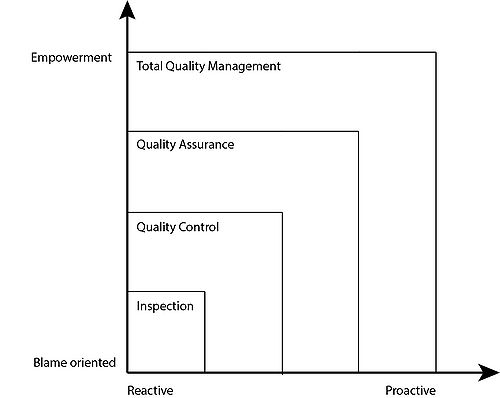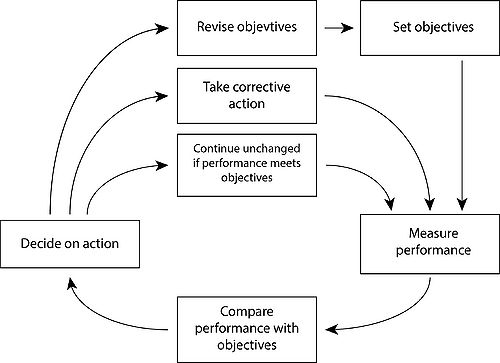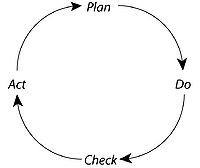Total Quality Management
Total Quality Management is a management approach where an organisation strive to provide customers with product and services of a high quality and a continuous improvement of the means to do so. TQM requires an establishment of a culture of improvement where quality is top priority in the whole organisation; from floor to top management. The culture needs quality in all aspects of the organisation’s operations and seeks to integrate all organisational functions focusing on compliance with customer needs. The focus is proactive; processes and productions is being done right initially in order to eliminate defects and waste.
Total Quality Management (TQM) is a Quality Management System (QMS) where a culture of improvement results in an organisation continuously improves the quality of products and service to costumers. Total Quality Management was popular in the late 1980s and early 1990s, but the use of TQM is not too widespread today due to competition from other management systems such as Lean Manufacturing and the ISO 9000 series.
Contents |
Quality Management Systems
The main goal in business is to focus on the profit and savings, and also on the additional revenue that a company can achieve. The way to reach this objective is found by eliminating errors throughout the operations, production of products and services at the level of quality desired by customers. Errors can increase amount of costs significantly. To avoid errors the Quality Management Systems (QMS) are used. The purpose of QMS is to secure quality of product and manage the communication between management and employees; telling them what is required to produce and what desired quality level to be achieved of specified products and services.
QMS consists of four main components:
- Inspection, where work is physically checked in order to secure that is has been completed satisfactorily.
- Quality Control (QC), where management control techniques is used in order to achieve fulfilment of quality requirements.
- Quality Assurance (QA), where externally accredited procedures and techniques are used in order to ensure that quality management practices are carefully followed.
- Total Quality Management (TQM), where the organization is motivated to do continuous process improvements to achieve increasingly higher levels of quality.
The four different systems all vary in the degree of responsibility given from management to employees, also called empowerment, and in the degree of proactiveness, starting with completely reactive to being proactive (see figure: Quality Management Systems). The systems are getting increasingly more elaborated from Inspection to TQM.
These four systems will be further explained in the following sections.
Inspection
Inspection is "conformity evaluation by observation and judgment together with measurements and testing". It is the lowest degree of Quality Management. Usually inspection is executed by a third part who did not participate in the production of the object. The object is either accepted or rejected; following rejection goes either reworking or scrapping of the product, were additional costs follows. Furthermore, there are two more disadvantages of inspection. Firstly, dedication of ressource are required to the inspection progress. Secondly, the way of saving expenses and ressources with performing sampling method reduces the effectiveness of inspection itself. But inspection procedures are still vital for assurance of the product's quality and conformance with customer specifications.
Quality Control
Quality control is focused on fulfilling quality requirements. There are numerous of operation techniques available, but often reference is made to Ishikawa’s seven QC tools, which follows:
- Cause-and-effect-diagrams (also known as fishbone chart), where possible causes for effects or problems are identified.
- Check sheet, which is a structured, planned and prepared sheet for collecting and analyzing data. It is a general tool that can be used for several purposes.
- Control charts, which are graphs that show the development of one or more processes over time.
- Histogram, a tool for showing frequency distribution or how frequently a specific error or defect occurs.
- Pareto chart, is used to show which factors are most influential. Shown on a bar chart.
- Scatter diagram, a use of pairs of numerical data where a relationship between the pair is suspected. The data is input in a graph.
- Stratification, a separation of data from different sources, so patterns can be detected with more ease. E.g. data from different production facilities.
Quality Assurance
Quality Assurance is focused on providing confidence that quality requirements will be fulfilled. The aim of QA is to provide an overall set of procedures for the management of quality. QA specifies when and where inspections should take place using which criteria; and which QC tools should be used when. The QA system are not made to identify conformance or non-conformance by itself, but it simply provides the specifications for procedures of identification. There are three basic types of QA systems:
- First-party systems, where the organisation itself assures that it meets certain requirements.
- Second-party systems, where an association to which the organisation belongs provides the assurance.
- Third-party systems, where QA system is certified by an independent third party.
Best practice are third-party certification-based systems and these usually corresponds to the internatiol standards particularly the ISO 9000 series. The standards specify what a QA system should contain. Therefore, a client can feel confident that the company has the ressources and skills to implement processes that ensure client satisfactory service according to agreed quality standards.
Total Quality Management
Inspection, QC and QA all have two important limitations:
- They are first-order information loops (see figure: The Generic Information Loop) around static standards. Therefore performance is 100% if there are no defects.
- The systems only focus on operation and do not take, among other factors, customer satisfaction into account.
Thus continuous quality improvement is not a part of inspection, QC and QA.
TQM is focused on the creation of an culture of improvement; a culture where the whole organisation always strives to deliver quality products and improve quality by time. Quality improvement is the part of quality management focused on increasing the ability to fulfill quality requirements. The processes by which these improvements are created are usually called Total Quality Management.
TQM aims to deal with issues with encouraging continous improvement with regards to conformance by improving process capability and ensuring quality standards set for the process are suitable for the end product delivered to the customer. Therefore TQM is more an approach to managing the business than a strict defined set of quality management procedures and tools. As a project manager it is therefore important to create the right project culture and anchor the culture in everyone involved.
Principles of Total Quality Management
Management Commitment
"" It order to create a culture of improvement the involvment and commitment of the management must be present. The commitment can be materialized through the use of the Plan-Do-Check-Act Cycle', which is an iterative four-step method used in business to control continuous improvement of processes.
Employee Empowerment
Fact Based Decision Making
Fact Based Decision Making (FBDM) means that decisions should be made based on data and analysis and not based on beliefs. This approach should encourage managers on all levels to effectively make decisions based on data, considerations of all options and an analytic prediction of outcomes.
The following tools can be useful for FBDM:


